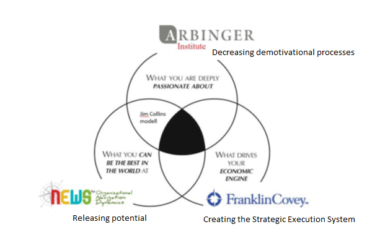Organizational culture development
The biggest challenge senior management can face in the 21st century
When talking about culture development, only methods and solutions based on international experiences and used by hundreds of companies can give you real safety.
Our background in organizational culture development
The first company of Improvers Group was founded in 1989. As we use various licenses our holding consists of different companies but our activities are connected therefore we can offer complex corporate development processes, for example organizational and executive culture developments. Our solutions are always unique processes customized to our clients’ companies.
In 2015 with our activities worth more than 1 billion HUF we became market leaders in our industry. We can save this position from year to year, in 2023 we are still No.1. on Book of List Hungary. Our mission is to work with the best know-hows of the world in order to help our clients’ organizations to remain competitive in this globalized world. Our most known licenses are: FranklinCovey, NEWS™, Arbinger Insitute, REFA, Lean, 6Sigma, IPMA, PMI.

We need to measure what we are developing
Improvers Organization Diagnosis
THE WAY TO UNEARTH THE INTERNAL POTENTIAL
Enterprise Development Diagnosis is an innovative tool developed through the integration of international research results. It helps organizations to unearth their internal potential and to keep their staff.
Enterprise Development Diagnosis is a fast and anonym tool which provides a well interpretable dataset which is a perfect base for benchmarking. The results show the current efficiency of the organization.
There is no 100% excellence but the secret for an enterprise is to always be better than the competitors in the industry. Not so good enterprises are bound to lose their key employees first and then their competitiveness.
The 58+5-text-based-query questionnaire is filled in by the enterprise’s employees in an anonym representative sample online. Four different diagnosis reports are generated from the final dataset:
- Diagnosis of Greatness; measures the efficiency of the management and the level of exploitation of internal potential
- Keep Your Staff Diagnosis; shows the chances of retaining the enterprise’s employees
- Human Negative Self-interest Diagnosis; measures the level of “organizational self-deception” and the energy used for the handling of internal conflicts; this energy is completely wasted and cannot be used for the completion of the strategic goals
- Organizational Time Management Diagnosis
(International researches used in the diagnosis: N.E.W.S.TM enterprise obstructions; Jim Collins Good to Great; Thomas intrinsic motivation, Arbinger self-deception)
What we believe in
We are convinced that the culture of a company is the real competitive advantage. What makes us different is that our development approach is practical.
The culture development approaches usually contain some characteristics or categories, e.g. Hierarchy culture. The development methods usually consists of series of workshops, aiming to change these categories in some direction. 28 years of Hungarian and international experiences couldn’t prove the efficiency of these methods.
Our experience is that every company has an own process of maturing. Neglecting this fact often means that things go back the way they were before the changes, or it can even cause damages. The culture contains real values, experiences, beliefs etc., and the development of a culture that brings real changes can’t be established without the building and harmonization of these areas.
Our organizational culture development
The process always starts with a proper exploration, which includes executive interviews, complex diagnosis (introduced above) and visiting the locations of the company.
- After collecting information we plan development pathways for the key areas of the organizational operation. These aren’t routine processes, they are suited to the diversified organization. Our approach is integrated and aligned and at the same time unique and customized to companies or units in different life-cycles.
- We introduce our solution to the senior management.
- We finalize the planning of the development process and define the culture together with the decision makers. Besides determining the goals, expense-, capacity- and time needs are stated as well.
- In both the planning and executing phase we aim to involve everyone who’s affected but also consider their work load.
- During the execution one of our senior consultant coordinates the development process.
- We work by a project plan, and we regularly cross-check it with the client. The real goal is not to end the project, but to reach the determined goals of the client and make sure that the project pays off.
- We regularly review the process (preferably every quarter). We make changes if needed.
- If necessary we use additional methods: PM Diagnosis, Lean radar, Digital transformational diagnosis.
- Runing the Organization Diagnosis year by year can monitor the progression of the whole process.
Our international concept
Our methodology focuses on the culture of „great organization”. In case of different life-cycles or development levels within a holding, we always seek organizational greatness.
Jim Collins’ Good to Great model defines perfectly the 3 areas that have the biggest effect on culture, and if any of them is left out of the development process, the change won’t be successful.
Passion (a culture that motivates)
Competencies (releasing inner potentials)
Results (strategic execution)

Introducing our incomparable developmental approach
High level of trust, human-and result focused culture
Organizations often seek to improve results through initiatives such as enhancing employee performance, boosting employee engagement, improving customer services, fostering accountability, developing leadership, strengthening teamwork, resolving conflicts and eliminating functional silos. Unfortunately, the success of these initiatives and the attempts to improve results is often inconsistent.
McKinsey discovered that these efforts fail because organizations “fail to recognize and shift mindsets.” In fact, the research shows that organizations that “identify and address pervasive mindsets at the outset are four times more likely to succeed in organizational-change efforts than are companies that overlook this stage.”
Arbinger helps organizations and employees:
to recognize their reactive, impedient, and in most cases self-deceptional mindset, which restrains functioning and destroys organizational trust.
to turn outward to become more solution-focused, collaborative and integrating.
gives tools to management that enables them to create proactive and goal-oriented systems and processes.
More information about Arbinger: www.arbinger.com
Releasing individual-, team- and organizational potentials with NEWS™
A unique intellectual property which integrates 25 years of international experience into one innovative system. It is a result-focused self-navigating system which can be extended to the whole organization. Its goal is to mobilize internal potentials in this constantly changing business world in order to reach organizational goals.
It is an integrated holistic system, which uses the same model on individual-, team- and organizational levels, this way it becomes a part and creator of the culture. It is structured, methodic and remarkably practical. With its help a „change-management” focused leadership mentality can be created, which results in a renewable, effective organization.
More information about NEWS™: https://newsnavigation.com/home/
Creating a high-performance culture with Strategic Execution System
FranklinCovey has studied the topic of execution for seven years in thousands of teams and in hundreds of organizations. Execution breaks down because of the conflict between the enormous amount of effort required to maintain an operation (your “day job” or what we call the “whirlwind”) and the goals for moving the operation forward. While both forces are necessary, they are not the same and do not get along. They compete for time, energy, and attention. Think about the key goals or strategies that you’ve seen die. How did they die? Did they come crashing down with a loud noise, or did they die quietly as they were suffocated by the “whirlwind”?
One of the most significant barriers to superior results in any organization is chronic inconsistency — the variation in performance between divisions, between departments, between shifts in the same department, and between people on the same shift. In every great organization, you will find pockets of great execution — a “top 20 percent” of high performance. The challenge is to move the middle 60 percent of your average workforce toward the higher performance level of the top 20 percent. Improvement of this magnitude doesn’t produce incremental results — it creates breakthrough results.
Contact us!

István Ecsédi
Phone: +36 20 923 54 05
E-mail: istvan.ecsedi@improversgroup.hu

